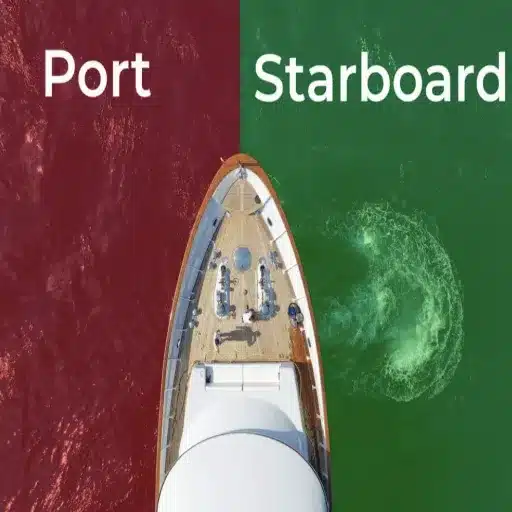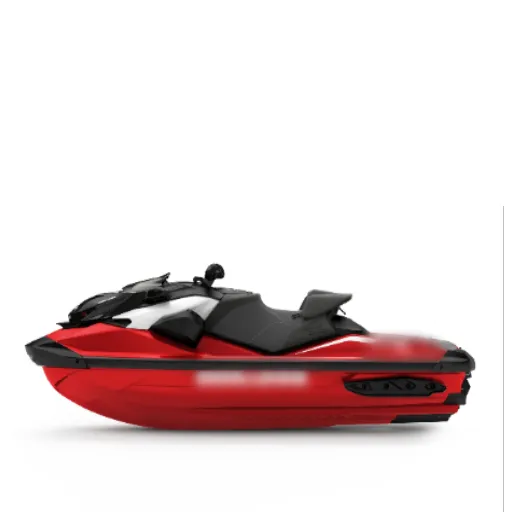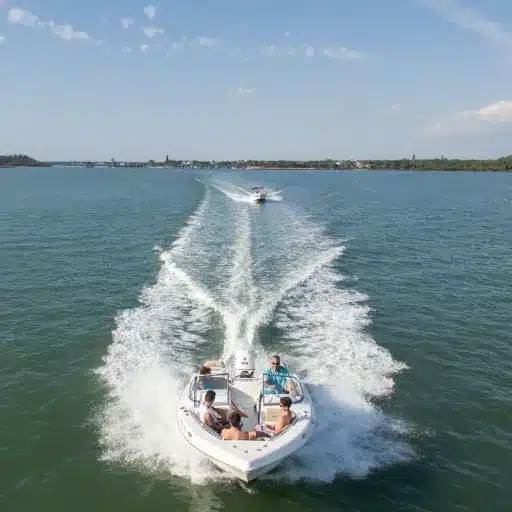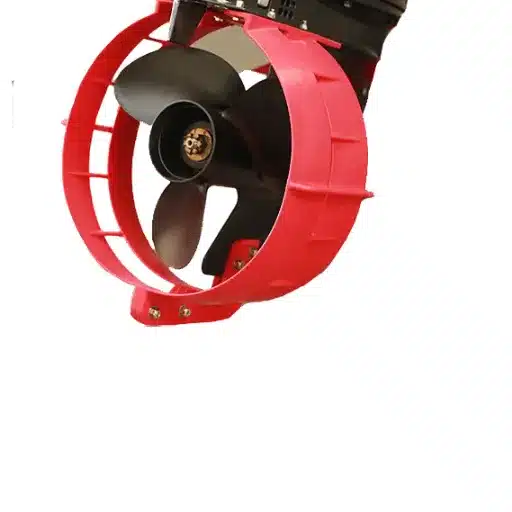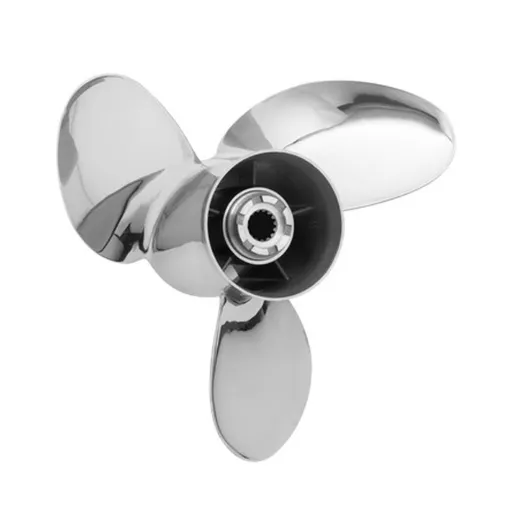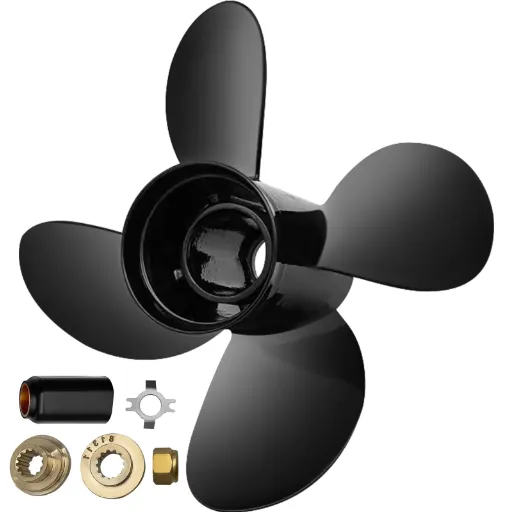Both enthusiasts and experts in the field of boating truly comprehend that a few terms and concepts about a vessel must be known for their safety and efficiency in the water. Generally, the term port side is among those basics on which sailing smoothly and avoiding mishaps depend. But what exactly ‘port side’ stands for, and why is it so crucial in modern-day boating practices in the year 2025? This article investigates the importance of the port side in communication, navigation, and overall coordination of the vessel. Whether an expert sailor, a recreational boater, or anyone trying to deepen their maritime expertise, this guide will give you some common sense for a smooth and fun voyage. Now, let’s embark on this journey to learn everything about the port side of a boat and why it has become more relevant than ever in the current ever-changing boating world.
Understanding the Basics of Boat Orientation
Naming Starboard and Port
When working on a boat, distinguishing port from starboard is essential for communication due to operational safety. These terms identify either side of a vessel, port for the left and starboard for the right, when looking towards the bow or front of a boat. Otherwise, the use of “left” and “right” can be confusing based on a person’s orientation.
According to folklore, “starboard” comes from Old English, meaning the side of steering the vessel, on which early boats were landed with a rudder or an oar. This was because “port” was chosen in preference over “larboard,” which sounded too much like “starboard” and could cause confusion in verbal commands. So “port” was selected because that side of the vessel was traditionally placed alongside the port or quay for loading and unloading cargo.
This standardized set of terminology nowadays remains key for traditional navigation and all the other new-age boating technologies and regulations. For example, port-side navigation lights shine red, and starboard-side ones shine green. The distinction between these two helps the sailor ascertain whether the vessel on the port or starboard side is approaching, especially under reduced visibility. These terms are pretty common among mariners in ensuring safety and efficient communication while at sea. Yet distinguishing these sides and understanding the operational context of their terms remains a vital skill for novice and experienced boaters alike.
The Need for Standard Terms in Boating
A set of terminology standardized in boating aids in seamless communication and hence ensures the safety of all individuals partaking in maritime activities. For instance, irrespective of the orientation of any given vessel, terms like “port” and “starboard” remain consistent, thereby eliminating any confusion based on directional ambiguity. Besides navigation, other terms such as “aft” (towards the back of the boat) and “bow” (towards the front of the ship) are equally crucial for operations like docking, anchoring, and maneuvering.
Maritime safety today emphasizes the importance of adopting a standardized language to prevent errors, especially during emergencies or adverse weather conditions. The studies highlight miscommunication as the human error contributing to maritime accidents, mainly providing strong support for the need for universal operational clarity. Standardization of language allows for the creation of common ground by mariners in instructions, so that the responses to instructions in various situations are quick and apt. Following these terms can significantly improve safety and working efficiency, irrespective of small sailboats or large commercial vessels.
How to Remember Port and Starboard
Some key associations make remembering port and starboard simpler. Thus, the port is on the left-hand side of the vessel when facing forward, while starboard is the opposite. One of the most common educational mnemonics is to relate the lengths of the words “port” and “left”: both words have four letters, establishing a mental association.
Another way is to use the colors to remember it. The port side has red navigation lights while green ones light up the starboard. Remember this by associating the port with red wine, which matches the bright red of the lights. On the other hand, starboard has an “R” placed just after the “sta,” just like right, thus reinforcing the connection.
Many sailors use simple repetition during training or practice sessions to reinforce terms and build muscle memory. Perhaps they shout the port or starboard side of the vessel during mock maneuvers so that recall may come almost instantaneously, ensuring precision and safety during actual use. These mechanisms serve to foster learning but also demonstrate how a prepared mariner proceeds while executing commands and responses.
The Port Side of a Boat
Characteristics of the Port Side
On a boat, the port side, found on the left when facing the bow, is universally marked with a red light. Clear communication and safety measures depend heavily on such color coding, especially at night or in low-visibility situations. The term “port” originated as a reference to the side traditionally used for docking at ports, ensuring it did not interfere with the steering oar of the ship on the opposite side. Now established as a long-standing maritime tradition, modern maritime rules clearly demarcate port and starboard sides.
Signals and markings on vessels highlight the importance of their port side to assist in navigation and ensure adherence to maritime rules of the road. The understanding of what distinguishes the port side from the starboard side-and its associated role and markers-is a required prerequisite for operational precision, navigation through tricky waterways, and teamwork among crew members during maneuvers.
Fixed Positions on a Vessel: Port Versus Starboard
The differentiation between port and starboard is critical for clear communication and safe navigation on any vessel. These standardized terms eliminate any potential confusion that could arise from using directional language, which depends on a person’s orientation on the ship. On a vessel, the port side (left side facing the bow) is fitted with red navigation lights, whereas the starboard side (right-facing the bow) is fitted with green navigation lights. This arrangement is in accordance with the international maritime conventions, which provide vessels from different countries with the information about each other’s direction and movement, mostly in night time or low-visibility conditions.
Precise identification of these sides is crucial during docking, maneuvering in restricted waterways, or encountering other vessels. For example, international regulations refer to the crossing situation where a ship with another on its starboard side has the right of way. This type of regulation thus highlights the universal need for the entire crew to be notified of these fixed locations. Port and starboard markers and other visual aids, such as buoys in the open sea or signage in the harbors, further assist these sides during the actual navigation process. The adoption of such universal standards thus directly reduces the risk of collisions and improves the efficiency of maritime operations.
Common Misconceptions about Port and Starboard
One big misconception about port and starboard is that they are times types of the words left and right. Port means left, and starboard means right when we say so from the front of the ship or bow orientation. They are unlike spatial words, such as left and right, that change places because port and starboard do not change based on the observer or the ship’s position, thus providing clarity in navigation or an emergency.
Another misunderstanding is based on the notion that port will always be marked red and starboard will always be marked green. The color system applies to navigational lights only. It is applicable at night but does not cover all maritime applications, such as interior ship design or external marking systems. This underscores the need to look around for situational awareness rather than focusing solely on color cues when navigating.
Moreover, some consider these nautical terms to be antiquated or redundant in today’s navigation systems. However, their use has been continually re-endorsed by global maritime bodies, who still regard them as critical for preventing communication errors, especially under the difficult conditions of language barriers while working in international waters. Port and starboard are universal terms that ensure operational efficiency and reduce potential conflicts among crew members of different dialects and vessels worldwide.
Boater Safety and Navigation
The Port Side: An Essential Ingredient in Safe Boating
The port side in a vessel is the first and foremost consideration for effective and safe boating practices. The avoidance of errors because of uncertainty of a port side position is the first in avoiding navigation problems, especially in high-traffic areas or in night navigation. According to International Navigation Conventions, the port side is given a red light to serve as a visual aid in conveying the orientation of a vessel to others. This nonvarying system serves to lessen the chances of collisions and maximize apt communication between vessels in conditions of diminished visibility.
Proper port-side navigation further complements the “rules of the road” for marine traffic. In a crossing-type situation, one must keep in mind the port side to ensure the operator can yield correctly to a vessel proceeding on its starboard side across it. This, combined with modern navigational aids such as radar and GPS, ensures the smooth flow of traffic and reduces the chances of accidents on water. Once boaters are taught to integrate the concept of port side into their practices consistently, marine safety will improve, along with a sense of confidence afloat.
Effects of Port and Starboard on Navigation
In the cases of collision avoidance and route planning, port and starboard designations are primarily used when navigating congested waterways or traversing international shipping routes. With 21st-century navigation technology advances such as AIS and electronic chart displays, these concepts are fed into systems to assist sailors in maintaining their proper course and following the rules of maritime traffic.
Statistics show that the highest percentage of maritime incidents result from improper positioning or yielding according to the port and starboard rules, which include near misses and collisions. In this way, keeping crew members conversant with such regulations and providing navigation systems that highlight safe navigation paths lessen risk. For instance, alerting through automated systems when a vessel on the port side has the right-of-way can enhance response times and situational awareness.
Making use of the distinctions supports mariners in making use of visual signals and radio transmissions to bring more clarity in the operations. On the other hand, port and starboard regulations on a larger scale support multimodal global shipping by ensuring the safe transit of cargo, which directly affects efficient cargo delivery and economic sustenance.
Boating Accident Case Studies Involving Port-Side Usage
Boat accidents often highlight the vital need to appreciate and comply with the port side navigation rules. The most astounding example occurred when a small fishing vessel collided with a commercial cargo ship. It was found during the investigation that the fishing vessel failed to give the right of way on the port side, even though the cargo vessel was following the rules of navigation. This resulted in heavy damage to the hull and caused environmental hazards due to the leakage of fuel. The necessity for explicit knowledge in port-side usage grows even more in situations where vessels of different sizes and speeds interact.
Additional examples include a small recreational boat entering a marked traffic lane on a busy waterway, leading to multiple collision chains as it overtook a sailboat on the wrong side. Data from maritime authorities substantiates that overlooking overtaking procedures on the port side is a significant cause of accidents in dense traffic areas. Training must be made mandatory; additionally, new technologies like collision avoidance systems need to be embraced to mitigate these risks.
Such instances, again, show how minor mishaps can have disastrous implications in port-side navigation comprehension. They reinforce the importance of continuous education and technological development, which will bring together younger operators under the flag of established maritime norms, regardless of their experience.
Trends in Boating for 2025
An Innovation in Nautical Technology: Effects on Port Side Awareness
An advancement in nautical technology is re-adjusting mariners’ mindsets toward navigation on the port side, thus ensuring safer and more efficient waterways. Integrated into navigation systems is the AR, a powerful, latest invention. AR overlays real-time visuals onto the video image, providing operators with precise spatial awareness, including port and starboard side indicators, potential obstacles, and permissible maneuvering routes.
Another development with significant potential for shaping navigation processes at the port-side is the installation of intelligent navigational software. This software processes massive datasets, which may include tide levels, weather conditions, and vessel traffic, to produce results that could prevent port-side misjudgments. Moreover, automatic alerts and adaptive guidance become second nature to crew members, helping to minimize navigation errors to the lowest level even in the most complicated situations.
Offering ever-so-precise navigation through the radar and sonar systems, especially in visibility-challenging portside conditions, increases awareness of the activity. Coupled with connectivity tools like Automatic Identification System (AIS) real-time vessel track, and dynamic digital charts, communication between vessels and control centers can be synchronized to a level where miscommunication becomes minimal, aligning with navigation instructions.
Its own counterparts are not just one approach to the traditional problems but set the very benchmark for maritime safety. Keeping these tools in continual evolution greatly reduces errors at portside, thereby increasing productivity and placing it alongside global standards of safety.
Environmental Processing for Modern Boaters
Eco-conscious boaters now must consider environmentally responsible practices in boat work to save ecosystems or in response to enforceable environmental regulations. Minimizing fuel consumption and emissions in the marine field is a significant area of intervention. Cleaner marine fuels and energy-efficient propulsion systems, such as hybrid or electric engines, provide a considerable drop in the environmental footprint of maritime activities. Research has found that these innovations can reduce greenhouse gas emissions by approximately 20-30% compared to conventional fuel technologies.
Waste management is another primary consideration. Boaters should adopt stringent onboard protocols for handling and disposing of waste, including plastics, oil, and hazardous materials, at designated landfill facilities in marinas. Single-use plastics are, for example, among the major pollutants affecting marine life, so many boaters are switching to sustainable reusable options.
It is also imperative to navigate through local ecosystems with utmost care. Anchorage in protected zones or near delicate habitats such as coral reefs may cause massive and irreparable damage. To avert such scenarios, GPS-based equipment and innovative mooring solutions are being used that could cause less disruption to underwater ecosystems.
Prevention of water pollution is another primary concern. Both pollution from bilge water and gray water adversely affect aquatic life. The problem is increasingly alleviated in the present age with the help of modern bilge systems equipped with filtration technology; worldwide standards are, of course, tightening for the better.
In doing so, modern-day boaters could play a crucial role in preserving the marine world for future generations by choosing these solutions and promoting awareness of nature conservation.
Educational and Training Trends for Boaters in 2025
In the worlds of teaching boats and boaters, it is projected that a sea change will occur by the year 2025, partly due to advances in technology and partly due to the ever-growing need to ensure sustainability. One notable trend is the incorporation of VR and AR training systems into the affairs of the boater. These immersive technologies simulate extremely realistic situations, such as an emergency response drill or the docking of a boat in adverse weather conditions, in a manner that does not actually endanger anyone. Being an interactive way to practice, such training aids in both skill development and boosting confidence among new and seasoned boaters.
Another major trend is the surge in online learning platforms custom-built for marine safety and for navigating local and international waterways. Such sites combine video tutorials, interactive modules, and live sessions of expert feedback to educate anyone in the world. In addition to learning approaches, there are concerted efforts to bring environmental consciousness to the forefront by focusing on their own eco-friendly boating practices, such as fuel-efficient navigation, waste disposal, and the use of green energy technologies. The approach encourages learners to incorporate sustainable practices in their boating activities to minimize environmental impact.
Training courses are also changing due to data analysis and technology. Smart boats and craft equipped with sensors and AI systems could provide real-time feedback on performance, allowing boaters to practice and fine-tune their technical skills. The curricula also begin to include these digital tools so that boaters can understand and effectively utilize the technology on board. Meanwhile, full-day workshops in cybersecurity for vessel systems are being developed to address concerns over vulnerabilities in connected equipment.
Updates in enforcement will require standardized certification by 2025, emphasizing hands-on skills rather than just theoretical knowledge. These certifications allow for international harmonization so that safe boating practices can be enforced across borders. Changes in education and training underscore the importance of safety and its enhancement through innovation and sustainability, thus cultivating a more responsible and capable generation of boaters.
Parts of a Boat Related to the Port Side
Key Components on the Port Side
Speaking about the port side of the boat, I should state that it is the left-hand side when you are facing toward the bow. From this side, red navigational lights are shown pursuant to sea laws to prevent collisions and navigational hazards at night or during bad visibility. Therefore, understanding the features and components on the port side will enhance your vessel layout knowledge and may improve your operational skills aboard.
Some key components found on the port side include mooring cleats for securing the boat while docking or anchoring. Additionally, many ships have port-side gunwales with reinforced edges on the upper side, where protection rails or fenders can be fitted to absorb impacts during docking. Sailboats place great importance on port-side rigging components, such as jib sheets or halyards, depending on whether the boat is working to windward or leeward. A good knowledge of such placement ensures smooth maneuvering.
On the whole, storage lockers, access points, or even safety equipment like life rings or extinguishers might be placed port-side in some vessels. These things may differ with boat type, but it always underlines how knowing the port-side layout is more than being versed in terminology- it is safety, preparedness, and confidence each time you set sail.
Comparative Study of Port Side and Starboard Side Features
In a comparison between port and starboard, both their functional discrimination and the safety of the boating environment should be considered. For me, the port side, being the left side of a boat looking forward, is often thought of as storage or accessibility. Port side is a good place for installing life rings, fire extinguishers, and other safety equipment. On the other hand, the starboard, being the right side, is also essential for navigation, and especially so during docking or when maritime rules stipulate it as the “give-way” side in some crossing situations.
An outstanding factor from my observation would be visibility. International maritime regulations consider the starboard side to be the priority side for navigation, mainly since the other vessel will concentrate on this side to ascertain the right of way. This aspect, however, has made the starboard side the central focal point during crossings or maneuvers on shared water because it demands greater attention whilst under operation. A starboard is given slightly more importance here, and a port side is given less. The port side, nevertheless, remains essential for balancing the vessel and arranging the storage.
To sum it up, the battle between the port and starboard sides is less about choosing one over the other but rather invoking their singular purpose. A blending of the knowledge of both sides results in better safety, observance of maritime rules, and the efficient running of a vessel. Lastly, in my humble opinion, perfecting the contrast between port and starboard involves preparing and staying alert, ensuring that all steering-from-the-helm or onboard duties proceed smoothly and safely.
Maintenance Tips for the Port Side of a Boat
Proper maintenance of the port side ensures longevity, safety, and better working performance for the vessel. Inspecting the hull for damage from time to time is necessary. Damages in this context may mean any kind of cracks, blistering, or abrasion affecting the structural integrity. Special attention is needed on those places that are subjected to wear because of docking or mooring. Cleaning the port side with marine-grade soap helps prevent a build-up of salt, grime, or algae, which can lead to corrosion or discoloration over time. Placement of fenders on the port side must also be checked and maintained to protect against impact damage during docking.
Also, check the condition of rubbing strakes or rub rails along the port side to ensure they are firmly fastened with sufficient wear. Any hardware installations, such as cleats, should be secured and assessed for signs of rust or other deterioration. Finally, waxing or sealing the port side at intervals protects the surface from UV damage and accentuates its beauty, keeping it efficient and visually perfect until your next voyage.
Reference Sources
- Discover Boating – National Safe Boating Week: 10 Tips for a Safe Voyage: Shares essential safety tips for boating, emphasizing preparation and awareness.
- Clipper Marine – 4 Easy Ways To Remember Which Side Of A Boat Is Port: Explains the port side of a boat and its significance in navigation.
- NOAA – Why do ships use “port” and “starboard” instead of “left”?: Provides historical and practical reasons for using “port” and “starboard” in boating.
- Savvy Navvy – Which side of the boat is Port, which is Starboard, and why?: Discusses the differences between port and starboard and their importance in boating.
- National Safety Council – Recreational Boating: Stay Safe on the Water: Offers safety tips for recreational boating, including navigation and awareness.
- Find more info now.
Frequently Asked Questions (FAQs)
What is the starboard side of a ship?
The port side of a vessel is on its left when facing towards the bow. The term is significant for navigation, ensuring one does not get confused with the right-hand side of a vessel, also known as the starboard side. Nautical terms port and starboard are used instead of left and right, so there remains no confusion on board a ship. Knowing that port refers to the left side will set everyone in sync when it comes time to dock your boat or in situations such as a collision. The difference between port and starboard never changes and hence forms a vital part of maritime language.
What is port from starboard?
The main difference between port and starboard lies in their fixed locations on a vessel. The port side is the left side of the ship when facing the bow; the starboard side is the right. These terms allow mariners to communicate accurately in the absence of left and right, which can be relative to an individual’s standing. One way to remember is that port is related to red, as the red navigation light is on the port side, whereas green lights are emitted from the starboard side. Such terminology, applied instead of left and right, enhances comprehension and safety on the water.
Why is it essential to use standard terms such as port and starboard?
For a sailor, knowing port from starboard is essential to navigating adaptive communication. These nautical terms provide a baseline to allow for contradictions, especially in urgent cases. For example, if an instruction must be given to a vessel about the direction for it to go, “turn to port” always means left, and “turn to starboard” means right. They really need this during narrow channel transits or docking maneuvers. Correct instructions using these terms ensure that every crew member understands, thereby maintaining safety and efficiency during operations on waterways.
How do you remember which is the port and which is the starboard?
Red is the color used to remember port, as the navigation lights on the port side are red. One way to recognize that port means left is by thinking of the phrase: “port has four letters.” In contrast, starboard is on the right side, and again, you can remember it because it has an “r” in the word. This mnemonic device is convenient for a sailor who needs to quickly recognize these terms while navigating a vessel or operating some part of a boat.
What are the standard navigational lights on the port side?
The standard port-side navigational lights are red, which pantomime to another vessel that this is the port side or the left side of the ship. Even during the day while sailing, understanding the meaning behind these lights significantly contributes to safe navigation. The red light complements the other boater in situating the presence and orientation of the vessel so that he could keep clear. In constriction, the starboard side should display an obstruction of green lights as well. Hence, knowing the colors and their respective meanings plays an integral part in all sea communication, especially if the water is crowded.
Isn’t it essential that the terms port and starboard be used for clarity?
Sharing clear directions between port and starboard, rather than just left or right, helps avoid confusion when giving directions. While left or right can change according to a person’s viewpoint, port and starboard never do. The need for this constant becomes apparent when there is an urgent decision to be made, like docking or navigating crowded zones. Using these nautical English terms ensures everyone understands the right direction, further maximizing water safety. The use of these terms in maritime English must stay alive for efficient communication on board.




